| Columns Retired Columns & Blogs |
Antique Sound Lab Explorer 805 DT monoblock power amplifier
Anyone over 40 who's worked in a hi-fi or record store will remember the Pfanstiehl catalog, a pulpy thing that most shopkeepers chained to their counters, like a phone book. Pfanstiehl made replacement styli for virtually every record-playing device of the day, and their catalog contained page after page of tiny line drawings of nothing but phonograph needles, all lovingly rendered in three-quarter view. You couldn't browse it without being brought up short: My God, how many different needles are there? And how is it possible that a single company could tool up for so many products and still make a profit?

I relive those feelings whenever I visit the Antique Sound Laboratory website, which contains descriptions of 36 amplifiers, 11 preamps, and more individual parts than I can count. (The company offers their home-wound transformers and other components to anyone who wants to buy them.) What's more, ASL adds several new products to their line every year. How is it possible that one company can work so hard and still succeed? (Wait a minute...)
I think there might be two secrets to ASL's success. First, they keep their tool-up costs low by doing almost everything in-house, from sheet-metal work to powder-coating to laminating and winding those trannies. Second, they have an imaginative design team that seems to thrive on challenging themselves. Would anyone out there be interested in a $99 push-pull monoblock? Here you go. How about a $400 passive preamp? Done. Anyone out there want a single-ended 2A3-tube amp with input transformers for less than $1000? No problem. To consider the wide range of ostensibly clever designs coming out of Antique Sound Laboratory is to believe these guys can turn on a dime.
Now comes one of their wildest concepts of all: a 50Wpc hand-wired, single-ended, transformer-coupled, parallel-feed, monoblock amplifier...that sells for less than $3000/pair. As they say in China, "What's not to like?"
Exploring the Explorer
The Explorer 805 DT is not the first high-powered single-ended triode (SET), of course; Audio Note's astronomically priced, 27Wpc Ongaku is probably the most well-known SET amp of all, if not the first to cross most hobbyists' attention; and others abound. Parallel feed isn't new, either, having been put to such fine use by Exemplar Audio's John Tucker. And the late Nobu Shishido showed everyone how good transformer interstage coupling could sound in the amplifiers he designed for WAVAC, the luxury brand that carries on his tradition.
But the ASL Explorer 805 makes use of all of that. And for all of that, the Explorer is simplicity incarnate. Input duties are performed by a dual-triode tube, the ubiquitous 12AX7. The cathode of that tube's second half is capacitively coupled to the grid of a pentode driver tube (a 6L6), said capacitor being a neat, retro-looking paper-in-oil design bearing the trade name Illusion. The music signal that appears on the driver's plate then goes through a coupling transformer to the grid of a direct-heated triode output tube: the "805" of the model number. A 20k ohm potentiometer is used to adjust the bias current that flows through the secondary of that coupling trannie.
Then, the AC signal that appears on the plate of the 805 tube is capacitively coupled (another olive-green Illusion cap) to the primary of the output transformer. DC rail voltage appears on that plate courtesy of a chunky plate-load transformer, itself mounted at the center of the Explorer: a place of honor.
That last bit is unique to parallel-feed designs. Normally—as if anything about single-ended amps could ever be considered normal—a SET is made in such a way that its rail voltage is tied to the plate of the output tube through the primary of the output transformer. That means the transformer must be able to handle significant DC voltage (300-900V, depending on the tube) and very wideband AC voltage—ie, the amplified music signal. That's an almost impossible combination of requirements, and that's why SET trannies tend to be so big and costly.
Parallel feed gets around all that—I mean literally around it—by letting the rail voltage bypass the output trannie on the way to the plate. Instead, it goes through a dedicated plate choke. That leaves the output transformer free to carry the AC music signal only, allowing the use of a smaller core than would otherwise be possible.
But to look at the Explorer's enormous output transformer, you'd be forgiven for wondering: How big would it be if not for the parallel feed? That is an imponderable. In fact, those up-to-date SET enthusiasts who already own parallel-feed amps may be surprised to know that the Explorer weighs a whopping 57 lbs—per channel.
Whereas the designers of other recent SETs have opted for tube rectification, the Explorer's power supply is a straightforward solid-state type, albeit with fairly old-fashioned devices for rectification and regulation, and a similarly traditional pi filter for the rail voltage. Beyond that, the only other unusual-for-a-SET touch is a thin white wire that goes from the 8-ohm output tap back to the cathode of the first half of the input tube: a negative feedback loop, without which the Explorer would tend to oscillate, the distributor says.
A look inside shows a mixture of superb parts and pedestrian ones, neatly planned wiring and improvisation. Apart from the digital voltmeter used in setting bias current and a pair of very small boards containing filament regulators, a power-up relay circuit, and other bits of silicon, the amp is hand-wired, point to point, and all parts are fastened directly to terminal strips, tube sockets, large reservoir caps, and the like. Modifiers can have a field day, I suppose, substituting their favorite caps, resistors, and hookup wire.
The Explorers were easy to use, although they required a bit more owner involvement than, say, a Naim NAP250. Separate gold-plated speaker connectors are on the back for 4, 8, and 16 ohms, plus return. A 100k ohm pot is there for balancing the voltage at the output tube's heater terminals, so the user can dial out hum if necessary (in my case, it wasn't). Then there's the bias adjustment, which requires some mention. The meter is switchable, and adjustments are meant to be made with the amplifiers connected for normal use—ie, without the use of shorting plugs on the input. The owner's manual suggests that, before powering up, the user should turn the bias voltage all the way down, to its lowest setting—approximately 0.8V. About 20 minutes later, bumping the bias to 1.2V is allowed. Then, finally, a maximum bias voltage of 1.4V can be dialed in after "several" hours of stabilizing. See what I mean about involvement?
Prior to receiving these review samples, I had had no experience with the 805, a large transmitting tube with a thoriated tungsten heater—meaning it burns brightly enough to double as a nightlight. I'm told that most 805s are made with a cap-style terminal for a separate high-voltage plate wire, but because that can make domestic users a bit nervous (and not without reason), the Explorer is intended for use only with the new Valve Art 805, which lacks that terminal. The importer, Divergent Technologies, says there's no reason the Explorers couldn't be modified to accommodate older types of 805 tubes, if desired. Zzzzzt!
Exploring the Music
Powering up the big Explorers was straightforward and uneventful. There was some audible hum at first, while the big caps charged (easy, Roy—I said caps), but that went away after a few seconds. Adjusting bias was straightforward: Settings, once arrived at, remained much more stable than with other fixed-bias amps of my experience. I thought the Explorers sounded better when their meters were switched off. (You can still adjust tube bias with the meters off, of course—you just can't see what you're doing.)
The Explorers' lack of input filtering became apparent the first time I used them to play an LP with an auxiliary turntable I'd set up on a floor-mounted stand: Footfalls induced some very-low-frequency feedback between the 'table and the rear-going output of one of my Quad ESL-989 speakers, coaxing that channel's amp into oscillation. I don't think that would be a problem for an experienced user with a well-set-up system, but I mention it in a cautionary way: Choose your preamp with care, and avoid those known to have problems with DC offset. For its part, the 805's sensibly high input impedance of 100k ohms should prove an easy load.
Generally speaking, the sound of the Explorers was spatially big, with pleasantly full bass and midbass registers. Driving my Quad ESL-989s, the Explorers endowed string bass, electric bass, orchestral drums, and the like with greater-than-average weight, yet with no apparent penalty in note timing. Even when used to drive my Lowther horns, which don't have a whole lot going on below 80Hz, the ASLs added more richness than usual to the sounds of those and other instruments—and I liked it.
The Explorers also did a consistently good job with musical and sonic textures. God knows I wouldn't dream of suggesting that the ability to reproduce the distinctions between the sound of a Marshall Plexi guitar amp (Mick Ralphs) and that of a Matchless DC30 (Gary Louris) should be important to a hi-fi enthusiast...but, important or not, these amps nailed them. They nailed all kinds of textures, in fact, though without anything in the way of brightness or tizz.
People who are leery of SETs may be calmed to know that, apart from my observations above, the Explorers behaved very well in my home—better, in fact, than a comparatively "conservative" push-pull design that came to visit. In other words, they didn't hum, incinerate my speakers, or make loud, uncalled-for, startling, bug-zapper sorts of noises.
After a few days' playing around with the Explorers and running them in, I began my serious listening with Cisco Records' recent reissue of the Dvorák Violin Concerto with Nathan Milstein and the Pittsburgh Symphony, under Steinberg (LP, Capitol SP8382). Oh, did the Explorers allow Milstein's fiddle to sound sweet! The spatial presentation was noticeably larger than usual, with all the instruments spread out—more or less realistically, I thought—on a stage much wider than usual. Yet the scale of the solo violin remained "right" throughout. And, again, its tone and texture were intensely pretty.
Of course, none of that would have mattered had the amps not gotten the notes right, in pitch and in time. But they did, and musical flow and tension were both served well. The line traced by the solo violin was unfailingly just that—a line, and one that was impossible not to follow—and the drama contained in the transition from the first movement to the Adagio was put across better than I'd ever heard before with this recording. I was thrilled: an emotionally as well as intellectually successful in-home performance.
I hinted early on that the Explorers weren't at all lacking in bass, and that was true with the Milstein and with most other records. The bottom octaves weren't egregiously boosted, but rather the effect was more like that of listening to music in a slightly bassy as opposed to bass-shy hall. The only negative was an accompanying excess of resonance—you could call it a "bloom" that got carried away with itself, I suppose—that I heard in the lowest brass notes during the Adagio of the Dvorák. That made me wonder if note decays weren't a bit too drawn-out. But that effect didn't interfere with the amplifiers' sense of flow, or with any other temporal qualities: If it was a distortion, it was inarguably euphonic.
- Log in or register to post comments



































